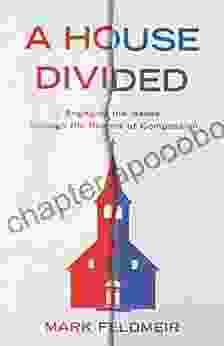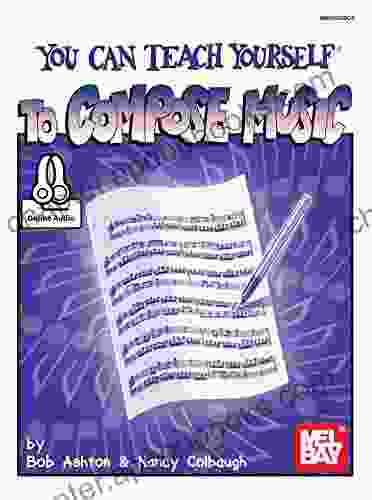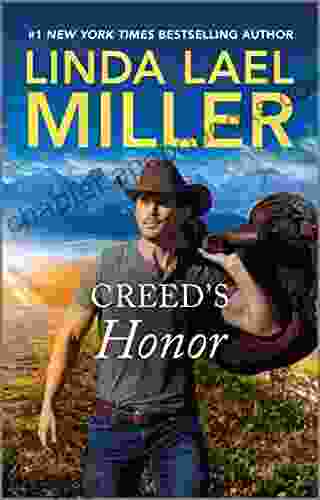You Can Teach Yourself to Compose Music: A Comprehensive Guide for Aspiring Composers

Music composition, once perceived as an elusive art reserved for the musically gifted, is now within your reach. With the advent of accessible resources and the power of self-discovery, you can embark on a transformative journey to unlock your musical potential and compose captivating pieces that resonate with your soul and captivate listeners.
Delving into the World of Music Theory
The foundation of musical composition lies in understanding the principles of music theory. This includes gaining a firm grasp of key concepts such as scales, intervals, chords, and rhythm. While music theory may seem daunting at first, breaking it down into manageable chunks and practicing regularly will help you develop a solid theoretical framework that will guide your compositions.
5 out of 5
| Language | : | English |
| File size | : | 14047 KB |
| Lending | : | Enabled |
| Screen Reader | : | Supported |
| Print length | : | 320 pages |
- Scales: Scales provide the building blocks for melodies. Learn the different types of scales, their construction, and how to use them effectively.
- Intervals: Intervals are the distance between two notes. Understanding intervals is crucial for creating melodies that are pleasing to the ear.
- Chords: Chords are combinations of three or more notes that create harmony. Explore different chord types, their inversions, and how to progress them smoothly.
- Rhythm: Rhythm governs the flow and movement of music. Study different rhythmic patterns and how to combine them to create dynamic compositions.

Online resources, books, and interactive software provide a wealth of information to help you grasp music theory. Dedicate time to practice these concepts, and you'll find your theoretical understanding blossoming.
Unleashing Your Melodic Imagination
Melody, the lifeline of music, conveys the emotional essence of a composition. To craft compelling melodies, embrace your creativity and experiment with different techniques:
- Motivic Development: Building melodies around short, memorable motives can create a sense of unity and coherence.
- Contour and Shape: Pay attention to the shape of your melodies, ensuring a balance of smooth contours and rhythmic variety.
- Ornamentation: Grace notes, trills, and turns can add embellishments and depth to your melodies.
- Range and Register: Consider the range of your melody and how it fits within different vocal or instrumental registers.
Listen to music from diverse genres to expand your melodic vocabulary and draw inspiration from the masters.
Building Harmonies that Enchant
Harmony, the tapestry of chords, provides support and depth to melodies. To build effective harmonies:
- Chord Progressions: Understand how chords relate to each other and create logical and emotionally impactful progressions.
- Inversions and Voicings: Explore different ways to arrange chord notes to create harmonic variety and interest.
- Non-Chord Tones: Introduce non-chord tones, such as suspensions and appoggiaturas, to add tension and color to your harmonies.
- Cadences: Use cadences to end musical phrases and create a sense of resolution or suspense.
Experiment with different chord combinations and progressions to discover the expressive power of harmony.
Creating Rhythmic Patterns that Pulse
Rhythm, the heartbeat of music, propels the composition forward and adds vitality. To create engaging rhythms:
- Meter and Time Signature: Choose an appropriate time signature and maintain a consistent meter throughout your composition.
- Syncopation: Shift rhythmic accents to create unexpected and compelling effects.
- Polyrhythms: Combine different rhythmic patterns to add complexity and interest.
- Articulation: Use articulation marks to indicate how notes should be played, affecting the rhythmic flow.
Tap your foot, clap your hands, and experiment with different rhythmic patterns to develop a strong rhythmic intuition.
Orchestration: Bringing Your Composition to Life
Once you have the basic elements of your composition in place, it's time to orchestrate it, choosing the instruments that will bring it to life. Consider the following:
- Instrument Ranges and Timbres: Familiarize yourself with the ranges and tonal qualities of different instruments.
- Sections and Layers: Divide your orchestra into sections, such as strings, woodwinds, brass, and percussion, and layer the instruments to create depth and texture.
- Dynamics and Articulation: Indicate the dynamics (volume) and articulation of each instrument to convey the desired musical expression.
- Balance and Mixing: Ensure a balanced mix of instruments to avoid overpowering or losing any part.
Listen to orchestral music and study scores to understand how composers use orchestration to enhance their compositions.
Music Notation: Capturing Your Musical Ideas
To preserve your musical creations, it's essential to learn music notation, the language of music. This will allow you to:
- Write down your compositions: Accurately capture your musical ideas on paper.
- Communicate with other musicians: Share your music with performers and collaborators.
- Document your musical journey: Preserve your compositions for future reference and posterity.
Invest time in learning the fundamentals of music notation, including note values, clefs, and rhythm symbols.
Songwriting: Crafting Complete Musical Expressions
If your passion lies in songwriting, embrace the art of weaving lyrics and music together:
- Lyrical Content: Write meaningful and engaging lyrics that complement the music and convey your message.
- Verse-Chorus Structure: Utilize the traditional verse-chorus structure or explore alternative song forms.
- Melody and Harmony: Craft memorable melodies and build harmonies that support the lyrics and create an emotional connection.
- Bridge and Outro: Introduce a contrasting bridge section and a satisfying outro to complete your song.
Study the lyrics and music of your favorite songs to learn from the masters of songwriting.
Embarking on this musical journey of self-discovery is a transformative endeavor. With dedication, passion, and the guidance outlined in this comprehensive guide, you possess the power to unlock your inner composer and create captivating musical pieces that will resonate with the world. Remember, the journey of musical composition is an ongoing exploration, filled with moments of inspiration, challenges, and ultimately, the profound joy of bringing your musical visions to life.
So, take the first step today, and let the symphony of your imagination soar. You can teach yourself to compose music, and the world eagerly awaits your musical creations.
5 out of 5
| Language | : | English |
| File size | : | 14047 KB |
| Lending | : | Enabled |
| Screen Reader | : | Supported |
| Print length | : | 320 pages |
Do you want to contribute by writing guest posts on this blog?
Please contact us and send us a resume of previous articles that you have written.
 Book
Book Novel
Novel Page
Page Chapter
Chapter Text
Text Story
Story Genre
Genre Reader
Reader Library
Library Paperback
Paperback E-book
E-book Magazine
Magazine Newspaper
Newspaper Paragraph
Paragraph Sentence
Sentence Bookmark
Bookmark Shelf
Shelf Glossary
Glossary Bibliography
Bibliography Foreword
Foreword Preface
Preface Synopsis
Synopsis Annotation
Annotation Footnote
Footnote Manuscript
Manuscript Scroll
Scroll Codex
Codex Tome
Tome Bestseller
Bestseller Classics
Classics Library card
Library card Narrative
Narrative Biography
Biography Autobiography
Autobiography Memoir
Memoir Reference
Reference Encyclopedia
Encyclopedia Lori Soard
Lori Soard Rick Emmer
Rick Emmer Lp Snyder
Lp Snyder Vijay Seshadri
Vijay Seshadri Leonard Peikoff
Leonard Peikoff Mariano Orzola
Mariano Orzola Marilyn Chin
Marilyn Chin Nichole Mcelhaney
Nichole Mcelhaney Leslie Braswell
Leslie Braswell Susan Landau
Susan Landau Louise Selby
Louise Selby Linda A Wood
Linda A Wood Lili Valente
Lili Valente Simon Brett
Simon Brett Lindy Everbridge
Lindy Everbridge Lindsey Kelk
Lindsey Kelk Maggie Sullivan
Maggie Sullivan Manuela Stefan
Manuela Stefan Marion Zimmer Bradley
Marion Zimmer Bradley Mary Westhumble
Mary Westhumble
Light bulbAdvertise smarter! Our strategic ad space ensures maximum exposure. Reserve your spot today!

 Carlos FuentesDiscover the Profound Insights of 'All For the Best' by Luigi Pirandello: A...
Carlos FuentesDiscover the Profound Insights of 'All For the Best' by Luigi Pirandello: A...
 Fernando BellThe Indelible Legacy of P.G. Wodehouse: A Literary Journey into the Heart of...
Fernando BellThe Indelible Legacy of P.G. Wodehouse: A Literary Journey into the Heart of... Clarence MitchellFollow ·12k
Clarence MitchellFollow ·12k José SaramagoFollow ·13.6k
José SaramagoFollow ·13.6k Harrison BlairFollow ·4.8k
Harrison BlairFollow ·4.8k Richard SimmonsFollow ·9.2k
Richard SimmonsFollow ·9.2k Howard PowellFollow ·7.5k
Howard PowellFollow ·7.5k Kirk HayesFollow ·17.8k
Kirk HayesFollow ·17.8k Charles DickensFollow ·3.1k
Charles DickensFollow ·3.1k Quentin PowellFollow ·10.6k
Quentin PowellFollow ·10.6k

 W.H. Auden
W.H. AudenTerrorist Events Worldwide 2024: A Comprehensive Guide to...
Terrorism is a global threat that affects...

 Carson Blair
Carson BlairBeautifully Uplifting And Enchanting Novel Set In The...
Set in the beautiful West Country, this...

 Jeffrey Cox
Jeffrey CoxAn Utterly Captivating and Uplifting Story of One Woman's...
Immerse yourself in an extraordinary...

 Greg Foster
Greg FosterEngaging the Issues Through the Politics of Compassion
: The Power of...
5 out of 5
| Language | : | English |
| File size | : | 14047 KB |
| Lending | : | Enabled |
| Screen Reader | : | Supported |
| Print length | : | 320 pages |












